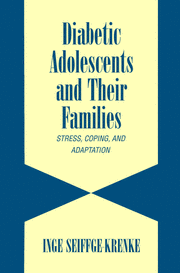Book contents
- Frontmatter
- Contents
- Foreword by Stuart T. Hauser
- Preface
- 1 Epidemiology of Chronic Illnesses in Adolescence
- 2 Coping with Illness in Adolescence: An Overview of Research from the Past 25 Years
- 3 Coping with Diabetes: A Longitudinal Study
- 4 Knowledge of the Illness, Compliance, and Patient–Physician Relationships
- 5 Self-Concept, Body Image, and Perceived Health
- 6 Adolescent, Parental, and Family Coping with Stressors
- 7 Chronic Illness and the Family: The Perspectives of Mothers, Fathers, and Siblings
- 8 Friendships, Romantic Relationships, School, and Career
- 9 Successful Adaptation or the Development of Psychopathology?
- 10 Pathways for Resolving the Dilemma between Developmental Progression and Adaptation to the Illness
- 11 Implications for Prevention and Intervention
- References
- Index
8 - Friendships, Romantic Relationships, School, and Career
Published online by Cambridge University Press: 06 August 2009
- Frontmatter
- Contents
- Foreword by Stuart T. Hauser
- Preface
- 1 Epidemiology of Chronic Illnesses in Adolescence
- 2 Coping with Illness in Adolescence: An Overview of Research from the Past 25 Years
- 3 Coping with Diabetes: A Longitudinal Study
- 4 Knowledge of the Illness, Compliance, and Patient–Physician Relationships
- 5 Self-Concept, Body Image, and Perceived Health
- 6 Adolescent, Parental, and Family Coping with Stressors
- 7 Chronic Illness and the Family: The Perspectives of Mothers, Fathers, and Siblings
- 8 Friendships, Romantic Relationships, School, and Career
- 9 Successful Adaptation or the Development of Psychopathology?
- 10 Pathways for Resolving the Dilemma between Developmental Progression and Adaptation to the Illness
- 11 Implications for Prevention and Intervention
- References
- Index
Summary
In recent years, studies have examined the close interaction between the family system and the adolescent's external relationships (e.g., Shulman, Seiffge-Krenke, Levy-Shift, Fabian, & Rotenberg, 1995). Emphasis has been placed on the continuous nature of relationship systems involving the family, friends, and romantic partners. From the beginning of puberty onwards, adolescents spend an increasing amount of time away from their families. They seek and maintain close friendships and begin romantic relationships. Friends of the same age are very important for developing a sexual identity as well as for establishing contact with romantic partners. Friends help the adolescent in choosing and defining outward appearance and in learning age- and gender-specific behaviors. Moreover, the first romantic relationships are typically initiated with the guardianship and guidance of close friends (Furman, Brown, & Feiring, 1999; Seiffge- Krenke, 1995). Another important facet of adolescents' social environment, the transition to employment, is also moderated by peer relationships. Achievement orientation in school and the competition in and volatility of certain job markets can, however, cause relationships with peers to become a source of stress as well as social support. This issue will receive particular attention in the following analysis of the extended social worlds of chronically ill adolescents.
The Friendships of Chronically Ill Adolescents
Peer relationships and close friendships are of great importance to adolescents.
- Type
- Chapter
- Information
- Diabetic Adolescents and their FamiliesStress, Coping, and Adaptation, pp. 166 - 202Publisher: Cambridge University PressPrint publication year: 2001



